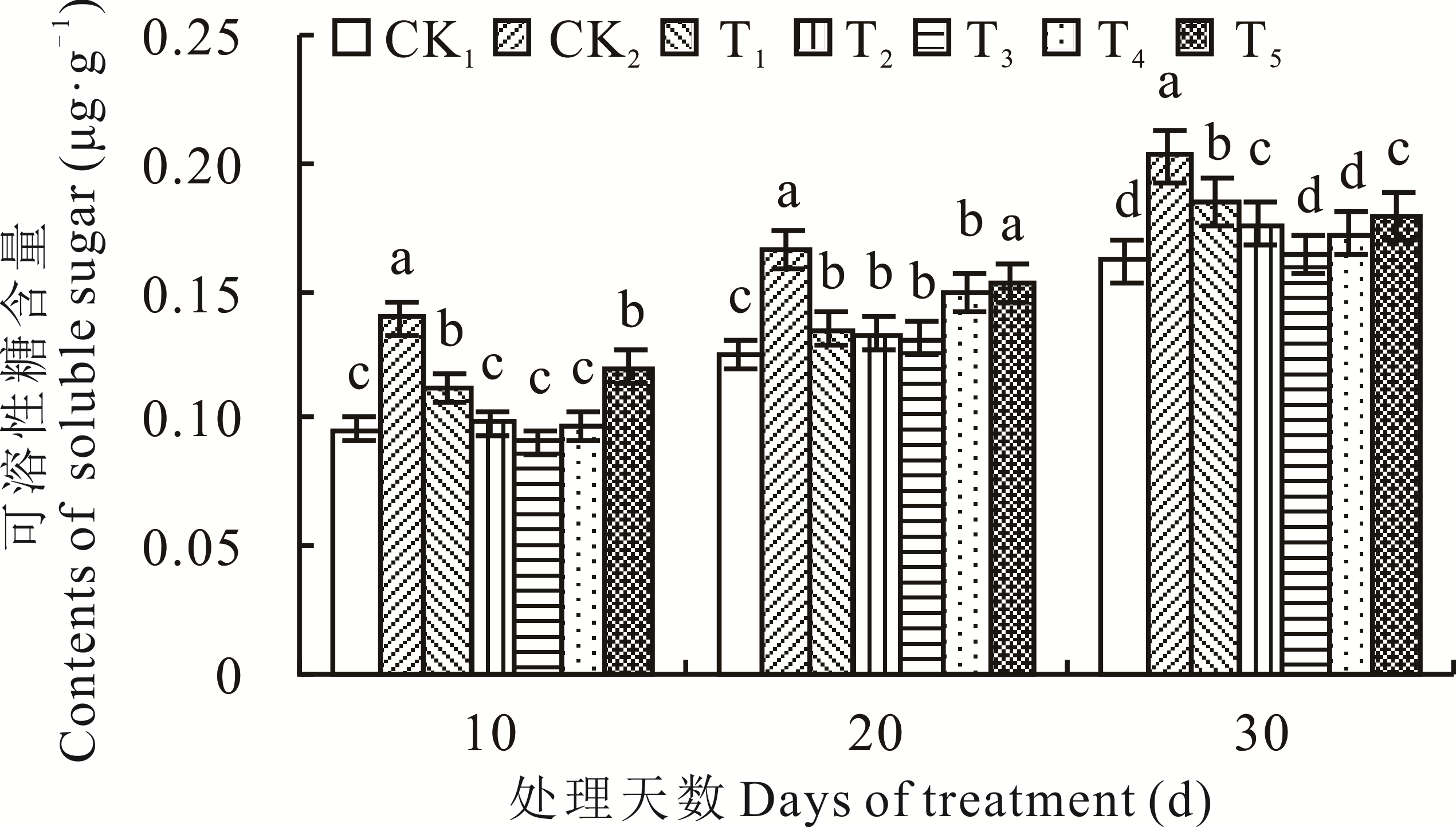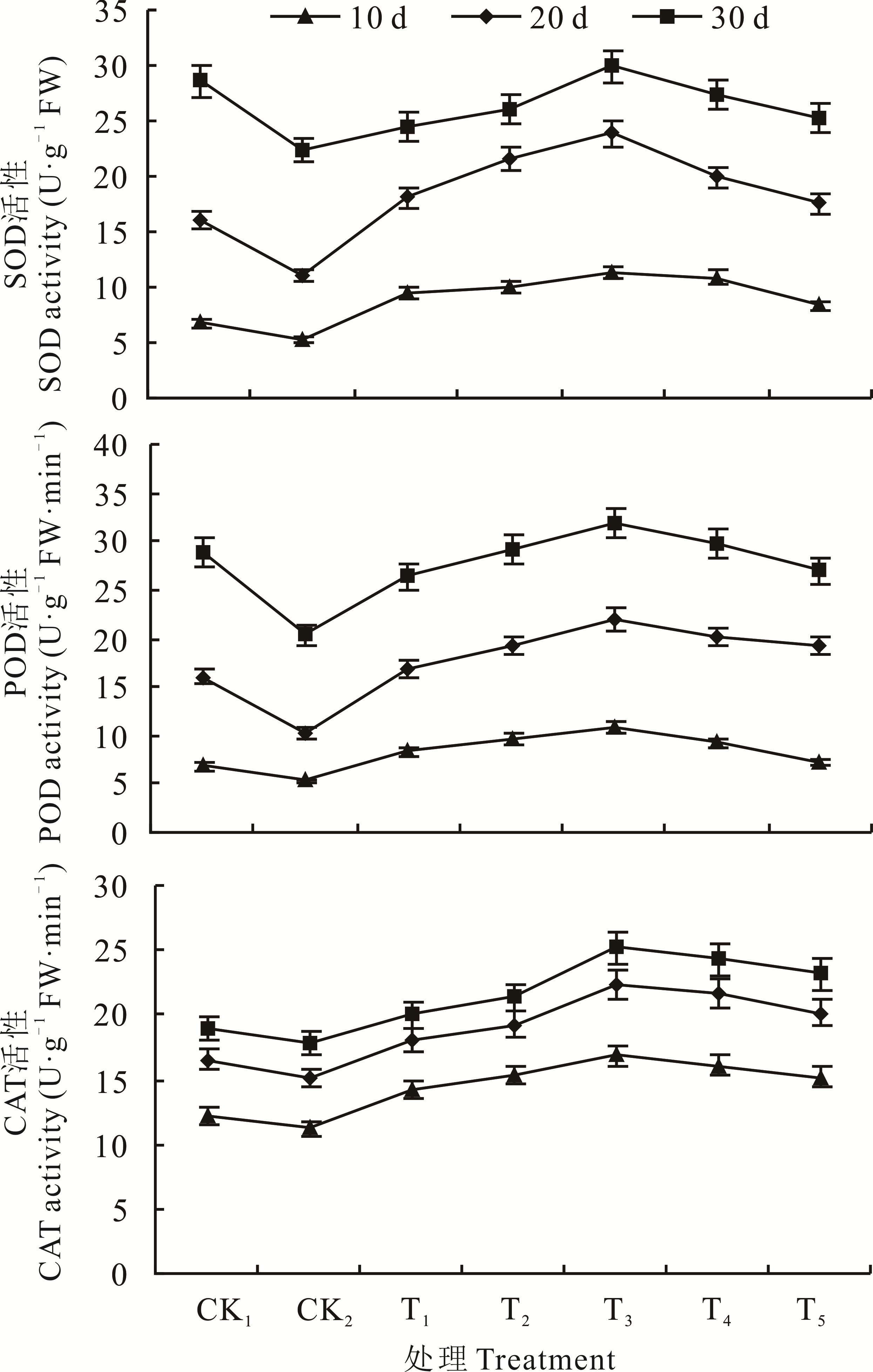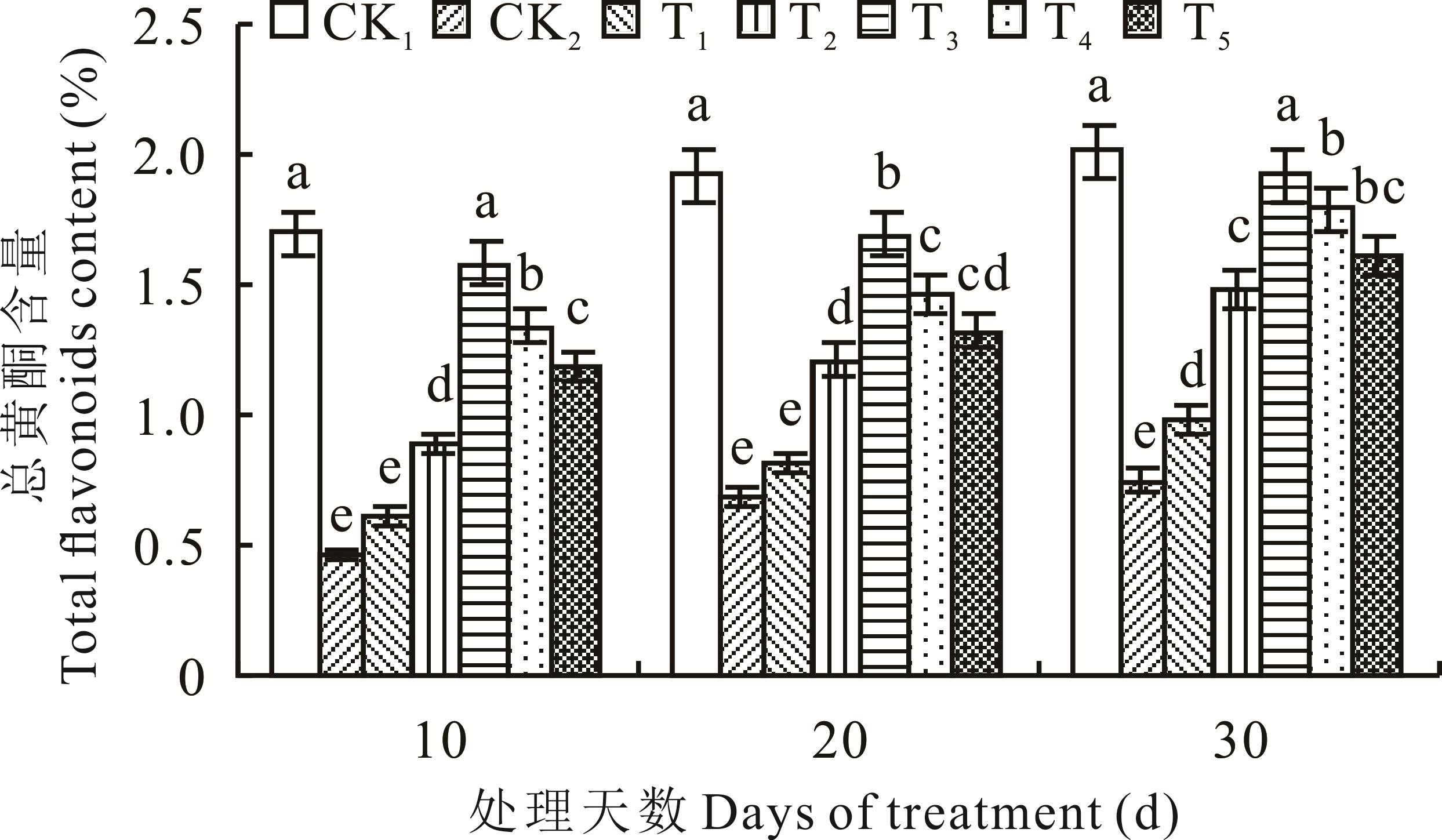

ISSN 1004-5759 CN 62-1105/S


草业学报 ›› 2021, Vol. 30 ›› Issue (7): 148-156.DOI: 10.11686/cyxb2020269
收稿日期:2020-06-15
修回日期:2020-07-21
出版日期:2021-07-20
发布日期:2021-06-03
作者简介:柳福智(1976-),男,副教授,博士。E-mail: lfz_1976@126.com
基金资助:
Fu-zhi LIU( ), Ying-fang ZHANG, Yuan CHEN
), Ying-fang ZHANG, Yuan CHEN
Received:2020-06-15
Revised:2020-07-21
Online:2021-07-20
Published:2021-06-03
摘要:
本研究以甘草无菌苗为试验材料,采用植物组织培养的方法,分析50 mmol·L-1 NaHCO3 胁迫下外源海藻糖对甘草幼苗生长量、叶绿素含量、渗透调节物质含量、抗氧化保护酶活性和总黄酮含量的影响。结果表明: 50 mmol·L-1 NaHCO3 胁迫显著降低了甘草幼苗的生长量、叶绿体色素含量、K+ 浓度、抗氧化保护酶(SOD、POD、CAT)活性和总黄酮含量,显著提高了丙二醛、脯氨酸和可溶性糖含量以及Na+浓度;施加15 mmol·L-1 海藻糖可显著提高甘草幼苗的生长量,提高叶绿素含量、K+ 浓度和总黄酮含量,降低丙二酸含量、脯氨酸含量、可溶性糖含量和Na+ 浓度,并且提高抗氧化保护酶活性。因此,NaHCO3胁迫下施加外源海藻糖对甘草幼苗生长具有良好的调节作用,可以增强甘草的抗碱能力,促进甘草幼苗生长。本研究为外源海藻糖提高甘草耐碱性和揭示其调控机制提供理论依据。
柳福智, 张迎芳, 陈垣. 外源海藻糖对NaHCO3胁迫下甘草幼苗生长调节及总黄酮含量的影响[J]. 草业学报, 2021, 30(7): 148-156.
Fu-zhi LIU, Ying-fang ZHANG, Yuan CHEN. Effects of exogenous trehalose on growth regulation and total flavonoid content of Glycyrrhiza uralensis seedlings under NaHCO3 stress[J]. Acta Prataculturae Sinica, 2021, 30(7): 148-156.
处理 Treatment | 根长 Root length (cm) | 株高 Height (cm) | 单株鲜重Fresh wight (g·plant-1) | |
|---|---|---|---|---|
| 根系Root | 全株 Whole plant | |||
| CK1 | 9.00±0.97a | 6.20±0.75a | 0.064±0.007a | 0.172±0.015a |
| CK2 | 7.30±0.25b | 4.77±0.39bc | 0.044±0.002b | 0.145±0.041b |
| T1 | 9.09±0.27a | 6.07±0.28ab | 0.050±0.003ab | 0.154±0.025ab |
| T2 | 9.23±0.33a | 6.57±0.09a | 0.057±0.007ab | 0.162±0.021ab |
| T3 | 9.47±0.12a | 7.40±0.12a | 0.067±0.007a | 0.173±0.070a |
| T4 | 9.13±0.20a | 6.17±0.29a | 0.061±0.014a | 0.153±0.010ab |
| T5 | 8.76±0.47a | 5.83±0.54ab | 0.047±0.025b | 0.147±0.040b |
表1 NaHCO3胁迫下不同浓度海藻糖对甘草幼苗生物量的影响
Table 1 Effects of trehalose at different concentrations on the biomass of licorice seedlings under NaHCO3 stress
处理 Treatment | 根长 Root length (cm) | 株高 Height (cm) | 单株鲜重Fresh wight (g·plant-1) | |
|---|---|---|---|---|
| 根系Root | 全株 Whole plant | |||
| CK1 | 9.00±0.97a | 6.20±0.75a | 0.064±0.007a | 0.172±0.015a |
| CK2 | 7.30±0.25b | 4.77±0.39bc | 0.044±0.002b | 0.145±0.041b |
| T1 | 9.09±0.27a | 6.07±0.28ab | 0.050±0.003ab | 0.154±0.025ab |
| T2 | 9.23±0.33a | 6.57±0.09a | 0.057±0.007ab | 0.162±0.021ab |
| T3 | 9.47±0.12a | 7.40±0.12a | 0.067±0.007a | 0.173±0.070a |
| T4 | 9.13±0.20a | 6.17±0.29a | 0.061±0.014a | 0.153±0.010ab |
| T5 | 8.76±0.47a | 5.83±0.54ab | 0.047±0.025b | 0.147±0.040b |

图1 NaHCO3胁迫下不同浓度海藻糖对甘草幼苗叶绿素含量的影响不同小写字母表示各处理间具有显著差异性(P<0.05)。下同。Different letters indicate significant differences (P<0.05) among treatments. The same below.
Fig.1 Effects of trehalose concentration on chlorophyll content in licorice seedlings under NaHCO3 stress

图3 NaHCO3胁迫下不同浓度海藻糖对甘草幼苗中可溶性糖含量的影响
Fig.3 Effects of trehalose at different concentrations on soluble sugar content in licorice seedlings under NaHCO3 stress

图5 NaHCO3胁迫下不同浓度海藻糖对甘草幼苗中Na+浓度、K+浓度和K+/ Na+的影响
Fig.5 Effects of trehalose at different concentrations on Na+ concentration,K+ concentration and K+/Na+ in licorice seedlings under NaHCO3 stress

图6 NaHCO3胁迫下不同浓度海藻糖对甘草幼苗中SOD、 POD、 CAT活性的影响
Fig.6 Effects of trehalose at different concentrations on SOD,POD, CAT activity in licorice seedlings under NaHCO3 stress

图7 NaHCO3胁迫下不同浓度海藻糖对甘草幼苗中总黄酮含量的影响
Fig.7 Effects of different concentrations of trehalose on total flavonoid content in licorice seedlings under NaHCO3 stress
| 1 | Xu N. There is a cure for land salinization, 2013(11): 74-76. |
| 许诺. 土地盐碱化有了治愈良药. 环境, 2013(11): 74-76. | |
| 2 | Wang B, Xie G Q, Liu Z L, et al. Mutagenesis reveals that the OsPPa6 gene is required for enhancing the alkaline tolerance in rice. Frontiers in Plant Science, 2019, 10(8): 88-92. |
| 3 | Imre C, Tünde T, Bettina S, et al. Electrical characterization of the root system: A noninvasive approach to study plant stress responses. Acta Physiologiae Plantarum, 2019, 41(10): 25-31. |
| 4 | Pharmacopoeia Commission. Pharmacopoeia of the People’s Republic of China. Beijing: China Pharmaceutical Science and Technology Press, 2015: 86-87. |
| 药典委员会. 中华人民共和国药典. 北京: 中国医药科技出版社, 2015: 86-87. | |
| 5 | Liu H R, Liu S S. Compendium of Materia Medica. Beijing: Huaxia Press, 2013. |
| 刘衡如, 刘山水. 新校注《本草纲目》. 北京: 华夏出版社, 2013. | |
| 6 | Wang L X, Li J P, Li Q, et al. Research status and sustainable utilization strategy of Glycyrrhiza uralensis. Chinese Traditional and Herbal Drugs, 2009, 40(3): 496-499. |
| 王连喜, 李剑萍, 李琪, 等. 乌拉尔甘草研究现状与可持续利用对策. 中草药, 2009, 40(3): 496-499. | |
| 7 | Liu Y Y. Research progress on germplasm resources of Glycyrrhizae Radix et Rhizoma. Chinese Traditional and Herbal Drugs, 2013, 44(24): 3593-3597. |
| 刘洋洋. 甘草种质资源研究进展. 中草药, 2013, 44(24): 3593-3597. | |
| 8 | Lu S P, Sun Q, Wang J H, et al. Researches on influence factors and improvement of Radix Glycyrrhizae quality. Chinese Traditional and Herbal Drugs, 2005, 36(8): 1261-1263. |
| 鲁守平, 孙群, 王建华, 等. 影响甘草品质的因素与甘草品质改良的研究概况. 中草药, 2005, 36(8): 1261-1263. | |
| 9 | Müller J, Boller T, Wiemken A. Trehalose and trehalase in plants: Recent developments. Plant Science, 1995, 112(1): 1-9. |
| 10 | Cheng C. Natural biological preservation materials-characteristics and application of trehalose. Food and Fermentation Industry, 1996(1): 59-64. |
| 程池. 天然生物保存物质——海藻糖的特性和应用. 食品与发酵工业, 1996(1): 59-64. | |
| 11 | Li A M, Zhang Y Z, Xu H. Study and application of trehalose. Journal of Hanzhong Normal University (Natural Science Edition), 2003(6): 89-94. |
| 李爱民, 张银志, 徐晖. 海藻糖的研究与应用. 汉中师范学院学报(自然科学版), 2003(6): 89-94. | |
| 12 | Wang D, Luo Y, Gao Y M, et al. Effects of exogenous trehalose on the membrane lipid peroxidation in wheat seedlings under heat stress. Journal of Triticeae Crops, 2016, 36(7): 925-932. |
| 王迪, 罗音, 高亚敏, 等. 外施海藻糖对高温胁迫下小麦幼苗膜脂过氧化的影响. 麦类作物学报, 2016, 36(7): 925-932. | |
| 13 | Wang Z H, Kong D J, Chen L L, et al. Effects of exogenous trehalose on chlorophyll metabolism and chloroplast development under low nitrogen condition. Journal of Southern Agriculture, 2019, 50(6): 1191-1196. |
| 王志红, 孔德钧, 陈丽莉, 等. 低氮下外源海藻糖对烤烟叶绿素代谢及叶绿体发育的影响. 南方农业学报, 2019, 50(6): 1191-1196. | |
| 14 | Wang S G, Deng R F, Pei Y, et al. Effects of trehalose pretreatments on salt resistance in wheat seedlings in mian-yang 15. Journal of Southwest Agricultural University, 1992, 14(2): 182-185. |
| 王三根, 邓如福, 裴炎, 等. 海藻糖提高绵阳15号小麦幼苗耐盐能力的研究. 西南农业大学学报, 1992, 14(2): 182-185. | |
| 15 | Wang H L. Exogenous trehalose improve Arabidopsis thaliana salt tolerance. Harbin: Northeast Forestry University, 2011. |
| 汪红玲. 外源海藻糖提高拟南芥耐盐性的研究. 哈尔滨: 东北林业大学, 2011. | |
| 16 | Xie D W, Wang X N, Fu L S, et al. Effect of exogenous trehalose on germ length and seedlings freeze resistance of winter wheat under cold stress. Journal of Triticeae Crops, 2015, 35(2): 215-223. |
| 谢冬微, 王晓楠, 付连双, 等. 外源海藻糖对冬小麦低温下胚芽长及幼苗抗寒性的影响. 麦类作物学报, 2015, 35(2): 215-223. | |
| 17 | Liu X, Tong H Y, Tian L X, et al. Effects of exogenous trehalose on growth and physiological characteristics of maize seedling roots under chilling stress. Chinese Journal of Agrometeorology, 2018, 39(8): 538-547. |
| 刘旋, 佟昊阳, 田礼欣, 等. 外源海藻糖对低温胁迫下玉米幼苗根系生长及生理特性的影响. 中国农业气象, 2018, 39(8): 538-547. | |
| 18 | Hu H F, Ma Y H. A study on exogenous trehalose improving droughty resistance of cucumber. Journal of Shenyang Agricultural University, 2008(1): 83-85. |
| 胡慧芳, 马有会. 外源海藻糖提高黄瓜抗旱性研究初探. 沈阳农业大学学报, 2008(1): 83-85. | |
| 19 | Li F J, Zhou Q W, Qi X H, et al. Effects of trehalose on the growth of rice seedlings under cadmium stress. Journal of Agro-environment Science, 2019, 38(8): 1827-1834. |
| 李昉峻, 周其文, 漆新华, 等. 海藻糖对镉胁迫下水稻幼苗生长的影响. 农业环境科学学报, 2019, 38(8): 1827-1834. | |
| 20 | Zhang Z L, Zhai W J. Plant physiology experiment guidance. Beijing: Higher Education Press, 2008. |
| 张志良, 翟伟菁. 植物生理学实验指导. 北京: 高等教育出版社, 2008. | |
| 21 | Hao Z B, Cang J, Xu Z. Plant physiology experiment. Harbin: Harbin Institute of Technology Press, 2004. |
| 郝再彬, 苍晶, 徐仲. 植物生理实验. 哈尔滨: 哈尔滨工业大学出版社, 2004. | |
| 22 | Zhang Y B, Liu A R, Zhang X P, et al. Effect of exogenous NO on the growth and inorganic ion content of Festuca arundinacea seedlings under Pb2+ stress. Guihaia, 2009, 29(3): 360-365. |
| 张远兵, 刘爱荣, 张雪平, 等. 外源一氧化氮对铅胁迫下高羊茅生长和无机离子含量的影响. 广西植物, 2009, 29(3): 360-365. | |
| 23 | Li L. Experimental guidance of plant physiology module. Beijing: Science Press, 2008. |
| 李玲. 植物生理学模块实验指导. 北京: 科学出版社, 2008. | |
| 24 | Cang J, Zhao H J. Experimental course of plant physiology. Beijing: Higher Education Press, 2013. |
| 苍晶, 赵会杰. 植物生理学实验教程. 北京: 高等教育出版社, 2013. | |
| 25 | Yu Q, Ma M, Zhao H Y. Comparison the content of total flavonoids in different callus of Glycyrrhiza glabra L. Seed, 2011, 30(7): 4-7. |
| 余茜, 马淼, 赵红艳. 光果甘草不同愈伤组织中总黄酮含量的比较. 种子, 2011, 30(7): 4-7. | |
| 26 | He L, Lu Z H, Guan B, et al. Seed germination and seedling growth of the two sorghums under saline-alkali stress. Acta Botanica Boreal-Occident Sinica, 2012, 32(2): 362-369. |
| 何磊, 陆兆华, 管博, 等. 盐碱胁迫对两种高粱种子萌发及幼苗生长的影响. 西北植物学报, 2012, 32(2): 362-369. | |
| 27 | Tian L X, Qu D Y, Bi W S, et al. Trehalose alleviates the negative effects of salinity on the growth and physiological characteristics of maize seedlings. Acta Prataculturae Sinica, 2017, 26(8): 131-138. |
| 田礼欣, 曲丹阳, 毕文双, 等. 海藻糖对盐胁迫下玉米幼苗生长及生理特性的影响. 草业学报, 2017, 26(8): 131-138. | |
| 28 | Zhao Z. Physiological and molecular mechanism of oat in response to alkali stress. Hohhot: Inner Mongolia Agricultural University, 2019. |
| 赵洲. 燕麦响应碱胁迫的生理及分子机制研究. 呼和浩特: 内蒙古农业大学, 2019. | |
| 29 | Liu D, Li R H, Chen X. Effects of mixed salts of Na2CO3 and NaHCO3 on the growth and development of Carthamus tinctorius L. seedlings. Journal of Agricultural Catastrophology, 2018, 8(3): 54-55. |
| 刘丹, 李然红, 陈鑫. Na2CO3、NaHCO3混合胁迫对红花幼苗生长的影响. 农业灾害研究, 2018, 8(3): 54-55. | |
| 30 | Wang L J, Li J C, Liu Y F, et al. Effects of salicylic acid and CaCl2 on photosynthesis and chlorophyll fluorescence of citrus under heat and drought stress. Chinese Agricultural Science Bulletin, 2003, 19(6): 185-189. |
| 王利军, 李家承, 刘允芬, 等. 高温干旱胁迫下水杨酸和钙对柑橘光合作用和叶绿素荧光的影响. 中国农学通报, 2003, 19(6): 185-189. | |
| 31 | Zhao Y, Wei X H, Li T T. Effects of exogenous nitric oxide seed germination and seedling growth of Chenopodium quinoa under complex saline-alkali stress. Acta Prataculturae Sinica, 2020, 29(4): 92-101. |
| 赵颖, 魏小红, 李桃桃. 外源NO对混合盐碱胁迫下藜麦种子萌发和幼苗生长的影响. 草业学报, 2020, 29(4): 92-101. | |
| 32 | Yan D L, Zhang X Y. Effects of trehalose on growth and physiological indexes of evening primrose under salt stress. Hebei Forestry Technology, 2011, 46(3): 6-8. |
| 闫道良, 张晓艳. 海藻糖对盐胁迫下月见草生长和生理指标的影响. 河北林业科技, 2011, 46(3): 6-8. | |
| 33 | Chen S L, Peng Y, Zhou H, et al. Research advances in trehalose metabolism and trehalose-6-phosphate signaling in plants. Plant Physiology Journal, 2014, 50(3): 233-242. |
| 陈素丽, 彭瑜, 周华, 等. 植物海藻糖代谢及海藻糖-6-磷酸信号研究进展. 植物生理学报, 2014, 50(3): 233-242. | |
| 34 | Tian X Y, Liu Y J, Guo Y C. Effects of salt stress on Na+, K+, Pro, soluble sugar and protein of NHC. Pratacultural Science, 2008, 25(10): 34-38. |
| 田晓艳, 刘延吉, 郭迎春. 盐胁迫对NHC牧草Na+、K+、Pro、可溶性糖及可溶性蛋白的影响. 草业科学, 2008, 25(10): 34-38. | |
| 35 | Liu J X, Ou X B, Wang J C, et al. Exogenous H2O2 improves alkaline resistance of oat seedlings by regulating active oxygen metabolism and osmolyte accumulation. Acta Prataculturae Sinica, 2018, 27(2): 97-104. |
| 刘建新, 欧晓彬, 王金成, 等. 过氧化氢提高燕麦幼苗耐碱性的活性氧代谢和渗透调节. 草业学报, 2018, 27(2): 97-104. | |
| 36 | Liu B S, Xue H H, Li M, et al. Effect of salt-alkali stress on leaf ion contents of Leymus chinensis. Chemical Engineering Design Communications, 2019, 45(10): 150-151. |
| 刘滨硕, 薛洪海, 李明, 等. 盐碱胁迫对羊草叶片离子含量的影响. 化工设计通讯, 2019, 45(10): 150-151. | |
| 37 | Zhao Y, Yang K J, Li Z T, et al. Alleviation of salt stress during maize seed germination by presoaking with exogenous sugar. Chinese Journal of Applied Ecology, 2015, 26(9): 2735-2742. |
| 赵莹, 杨克军, 李佐同, 等. 外源糖浸种缓解盐胁迫下玉米种子萌发. 应用生态学报, 2015, 26(9): 2735-2742. | |
| 38 | Wu G Q, Li H, Lei C R, et al. Effects of additional KCl on growth and physiological characteristics of sainfoin (Onobrychis viciifolia) under high salt stress. Acta Prataculturae Sinica, 2019, 28(6): 45-55. |
| 伍国强, 李辉, 雷彩荣, 等. 添加KCl对高盐胁迫下红豆草生长及生理特性的影响. 草业学报, 2019, 28(6): 45-55. | |
| 39 | Wu X X, Gao H M, Zhang B, et al. Relationship of defensive enzymes and active oxygen of Puccinellia tenuiflora seedlings under Na2CO3 weak stress. Acta Prataculturae Sinica, 2006, 15(6): 87-91. |
| 吴晓霞, 高红明, 张彪, 等. 低浓度Na2CO3胁迫下星星草幼苗保护酶活性与活性氧之间的关系. 草业学报, 2006, 15(6): 87-91. | |
| 40 | Guo H J, Hu T, Fu J M. Effects of saline sodic stress on growth and physiological responses of Lolium perenne. Acta Prataculturae Sinica, 2012, 21(1): 118-125. |
| 郭慧娟, 胡涛, 傅金民. 苏打碱胁迫对多年生黑麦草的生理影响. 草业学报, 2012, 21(1): 118-125. |
| [1] | 吕娥娥, 周向睿, 周志宇, 赵桂琴. 荒漠灌木蒙古岩黄芪对干旱胁迫的生理响应[J]. 草业学报, 2016, 25(6): 42-50. |
| [2] | 刘建新, 王金成, 王瑞娟, 贾海燕. 外源过氧化氢提高燕麦耐盐性的生理机制[J]. 草业学报, 2016, 25(2): 216-222. |
| [3] | 吴旭红, 吕成敏, 冯晶旻. 外源一氧化氮(NO)对低温胁迫下南瓜幼苗氧化损伤的保护效应[J]. 草业学报, 2016, 25(12): 161-169. |
| [4] | 贾双双, 徐坤. 南方根结线虫侵染对不同抗性番茄砧木渗调物质及羟脯氨酸含量的比较[J]. 草业学报, 2015, 24(7): 123-130. |
| [5] | 刘爱荣,张远兵,钟泽华,吴夏,张明. 盐胁迫对彩叶草生长和渗透调节物质积累的影响[J]. 草业学报, 2013, 22(2): 211-218. |
| [6] | 刘慧芹,韩巨才,刘慧平,康欣然. 铅梯度胁迫对多年生黑麦草幼苗生理生化特性影响[J]. 草业学报, 2012, 21(6): 57-63. |
| [7] | 刘建新,王鑫,王瑞娟,贾海燕 . 黑麦草对NaHCO3胁迫的光合生理响应[J]. 草业学报, 2012, 21(3): 184-190. |
| [8] | 王金龙,赵念席,徐华,高玉葆. 不同地理种群大针茅生理生化特征的研究[J]. 草业学报, 2011, 20(5): 42-48. |
| [9] | 时丽冉, 牛玉璐, 李明哲. 苣荬菜对盐胁迫的生理响应[J]. 草业学报, 2010, 19(6): 272-275. |
| [10] | 孙宗玖,李培英,阿不来提,陈乐宁. 干旱复水后4份偃麦草渗透调节物质的响应[J]. 草业学报, 2009, 18(5): 52-57. |
| 阅读次数 | ||||||
|
全文 |
|
|||||
|
摘要 |
|
|||||